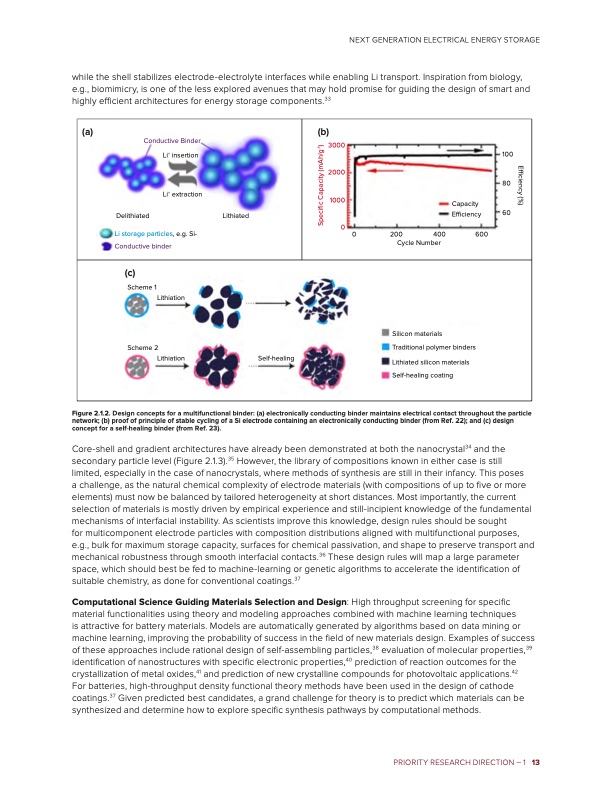
PDF Publication Title:
Text from PDF Page: 019
while the shell stabilizes electrode-electrolyte interfaces while enabling Li transport. Inspiration from biology, e.g., biomimicry, is one of the less explored avenues that may hold promise for guiding the design of smart and highly efficient architectures for energy storage components.33 Figure 2.1.2. Design concepts for a multifunctional binder: (a) electronically conducting binder maintains electrical contact throughout the particle network; (b) proof of principle of stable cycling of a Si electrode containing an electronically conducting binder (from Ref. 22); and (c) design concept for a self-healing binder (from Ref. 23). Core-shell and gradient architectures have already been demonstrated at both the nanocrystal34 and the secondary particle level (Figure 2.1.3).35 However, the library of compositions known in either case is still limited, especially in the case of nanocrystals, where methods of synthesis are still in their infancy. This poses a challenge, as the natural chemical complexity of electrode materials (with compositions of up to five or more elements) must now be balanced by tailored heterogeneity at short distances. Most importantly, the current selection of materials is mostly driven by empirical experience and still-incipient knowledge of the fundamental mechanisms of interfacial instability. As scientists improve this knowledge, design rules should be sought for multicomponent electrode particles with composition distributions aligned with multifunctional purposes, e.g., bulk for maximum storage capacity, surfaces for chemical passivation, and shape to preserve transport and mechanical robustness through smooth interfacial contacts.36 These design rules will map a large parameter space, which should best be fed to machine-learning or genetic algorithms to accelerate the identification of suitable chemistry, as done for conventional coatings.37 Computational Science Guiding Materials Selection and Design: High throughput screening for specific material functionalities using theory and modeling approaches combined with machine learning techniques is attractive for battery materials. Models are automatically generated by algorithms based on data mining or machine learning, improving the probability of success in the field of new materials design. Examples of success of these approaches include rational design of self-assembling particles,38 evaluation of molecular properties,39 identification of nanostructures with specific electronic properties,40 prediction of reaction outcomes for the crystallization of metal oxides,41 and prediction of new crystalline compounds for photovoltaic applications.42 For batteries, high-throughput density functional theory methods have been used in the design of cathode coatings.37 Given predicted best candidates, a grand challenge for theory is to predict which materials can be synthesized and determine how to explore specific synthesis pathways by computational methods. NEXT GENERATION ELECTRICAL ENERGY STORAGE (a) Conductive Binder Delithiated Lithiated Li+ insertion Li+ extraction Li storage particles, e.g. Si- Conductive binder (b) 3000 2000 1000 0 100 80 Capacity 60 0 200 Cycle Number Efficiency 400 600 (c) Scheme 1 Lithiation Scheme 2 Lithiation Self-healing Silicon materials Traditional polymer binders Lithiated silicon materials Self-healing coating PRIORITY RESEARCH DIRECTION – 1 13 Specific Capacity (mAh/g-1) Efficiency (%)PDF Image | Next Generation Electrical Energy Storage

PDF Search Title:
Next Generation Electrical Energy StorageOriginal File Name Searched:
BRN-NGEES_rpt-low-res.pdfDIY PDF Search: Google It | Yahoo | Bing
Sulfur Deposition on Carbon Nanofibers using Supercritical CO2 Sulfur Deposition on Carbon Nanofibers using Supercritical CO2. Gamma sulfur also known as mother of pearl sulfur and nacreous sulfur... More Info
CO2 Organic Rankine Cycle Experimenter Platform The supercritical CO2 phase change system is both a heat pump and organic rankine cycle which can be used for those purposes and as a supercritical extractor for advanced subcritical and supercritical extraction technology. Uses include producing nanoparticles, precious metal CO2 extraction, lithium battery recycling, and other applications... More Info
| CONTACT TEL: 608-238-6001 Email: greg@infinityturbine.com | RSS | AMP |